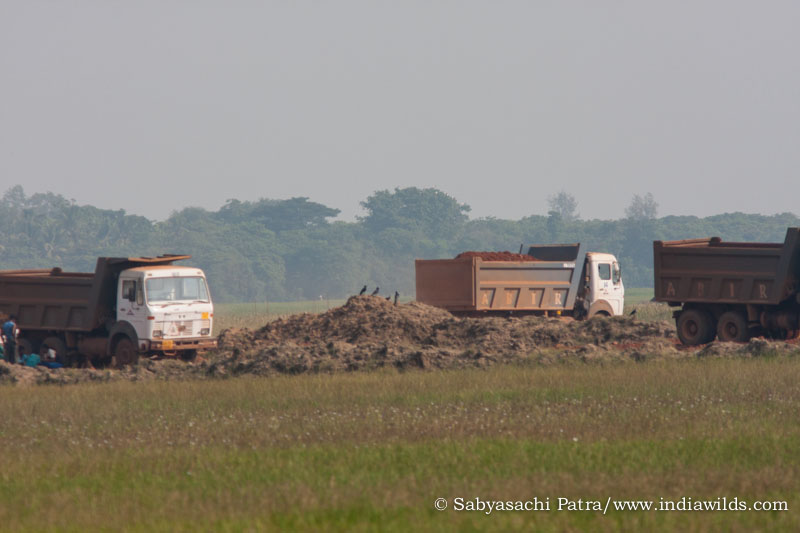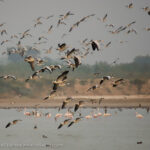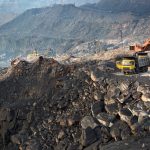IndiaWilds Newsletter Vol. 11 Issue III
ISSN 2394 – 6946
Environmental destruction, politics and our responsibility:
India celebrates many festivals every year with pomp and show. Perhaps one festival, the festival of elections, which comes up every five years, is very important as it impacts the lives of people. Soon India is going to face its general elections to elect members to the Lok Sabha. Various political parties have been in the process of finalizing their election manifestos, which promise broadly the actions that they are going to take if brought to power. George Schaller, one of the world’s preeminent field biologists who have inspired many others, had said that “Conservation, in the final analysis, is culture, economics and politics” (https://www.indiawilds.com/diary/indiawilds-newsletter-vol-10-issue-v/) So one may think that issues related to Climate Change, Conservation, Wildlife, forests would have found a place in the manifesto of political parties. Unfortunately that is farthest from the truth.
If all is well in the field of environment and wildlife then one may not raise voice. However, between 2014-2019 during the present term of the central Government, 682 out of 687 project proposals have been cleared by the National Board for Wildlife (NBWL). (99.82% projects in forests got nod, Hindu, Feb 13, 2019) So one may think that conservationists would have raised the issues related to environment, forests and Climate Change to get those included in the election manifestos of political parties. Unfortunately, that is farthest from the truth.
Issues related to Climate Change, wildlife, environment are conspicuously absent or some parts of it are hidden somewhere in the manifestos. Why is it so? Simple answer is the Conservationists have failed to do their duty.
Why the champions have failed to include those in the manifestos? Why have the champions failed to raise the issues infront of political parties?
Is it fear?
A recent Reuters survey says that 55% of English speaking Indians fear airing their political views online. In 2014 after the NDA Government was elected to power, NGOs were investigated and cases filed against them for misusing laws. NGOs said that they were being persecuted as they raised pertinent issues. Greenpeace was one of the prominent victims. It is easy to learn from others misfortunes and not take those steps, even if those are right things to do. So leading wildlife NGOs were muted or completely silent. It is true that not everyone has the moral courage like Mahatma Gandhi had so one can’t expect people to stand up for their beliefs and face persecution.
There were also some who completely sided with the ruling party’s scheme of things as they personally benefited. That is also understandable as it is human psychology.
If at all any issues of wildlife, forests and environment have got included then it is because of other pressure groups.
The pro-real estate focus of the ruling party made the Central Government to come up with draft to modify the CRZ (Coastal Regulation Zone) so that construction of buildings, resorts etc. can be done upto 10m close to the waterfront. The leader of a major opposition party Shri Rahul Gandhi while addressing a Fishermen’s Parliament in Kerala mentioned his opposition to the CRZ and his intention to change it if voted to power. This was because the fishermen were united against it and they represented a voting block, which the politicians wanted to tap. It is another matter that by 2100 the sea level is projected to rise by 6 meters (19.68 feet) and everything along the coast will be drowned and politicians are not even thinking about it. (“Climate Change: Pushing towards Noah’s Ark”, IndiaWilds, July 2018, https://www.indiawilds.com/diary/indiawilds-newsletter-vol-10-issue-vii/ )
Political parties will only listen when an issue is broken down to its parts to show the impact on various groups and hence the possibility of changing voter behaviour for or against it. The clear-cut cause and effect is not shown then no one is interested. Some of our politicians are not educated and also are not well read. The situation is so bad that some ministers have to take extraordinary steps to hide their graduation details. Well it is another matter that our politicians are not alone, as a recent testimony in US congress threw light about US President Donald Trump going to unusual lengths to hide his high school grades. Nevertheless the fact is not many politicians have the ability to understand complex subjects like conservation and its complex relationship with various wildlife and plant species as well as with earth, water and human lives.
To do this, conservationists or experts have to move out of their narrow domain and take a holistic view and explain it to people and politicians in lucid manner in a language people understand. Whereas publications in scientific journals would give weightage for career advancements, writing articles in popular journals will help change minds. And remember when there is public interest, there will also be more interest in research and funding in your own areas. Recently the HRD minister Shri Prakash Javadekar has said that research should only be done according to some predefined areas by the Government. So some of the research in wildlife biology, botany etc can be struck off from the list. So conservationists should wake up from their slumber.
Conservation is nothing but Philosophy of Life:
Wildlife biologists often point out that there is a complex web of inter-relationships between various species including humans and the wellbeing of all is interlinked. Unfortunately, Conservationists and our Government don’t take the same philosophy while talking about conservation. Conservation is all inclusive. The intricate balance of life in this Planet Earth needs to be protected. That ought to be the philosophy of life. Conservation is not simply picking and choosing what or whom to protect. So the approach has to be holistic.
Conservationists have to explain why a particular project is harmful for wildlife or why something is better for wildlife conservation, even if it is not a direct case of forest diversion or wildlife relocation.
Clean Energy:
For example, take the case of renewable energy. Solar power is becoming cheaper by the day. By 2022 there would not be any use case for setting up new coal power fired thermal power plants in India. The cost of Solar power has come down to 2.44 per kWH as per the July 2018 SECI auction. (https://economictimes.indiatimes.com/industry/energy/power/solar-tariffs-once-again-hit-all-time-low-of-rs-244-a-unit-at-seci-auction/articleshow/64834531.cms ) So now the thermal power at around 8 rupees is very costly. So many State electricity boards are officially breaking their power purchase agreements (PPAs) with Thermal Power Plants. Germany has officially announced that it is closing down coal fired power plants in a phased manner. Germany is closing down 12 GW of coal plants out of 42 GW in the next 4 years ie 28% of coal fired power plants are being phased out in next four years. This also amounts to 11.4% of the total power demand in Germany being moved away from fossil fuels. German Federal Minister for Economic Affairs and Energy Peter Altmaier had tweeted “Good for Business and Climate: … Less co2, more new Jobs. Security of Supply and Affordability: A strong Signal!”
Gut für Wirtschaft und Klima: Der Bericht der Klima/Kohlekommission wird von Wirtschaft- und Umweltverbänden breit getragen. Weniger co2, mehr neue Jobs. Versorgungssicherheit und Bezahlbarkeit: Ein starkes Signal!
— Peter Altmaier (@peteraltmaier) January 26, 2019
However, the players in coal are hitting back in various ways. It is said that along with vast swathes of pristine forests being sacrificed for coal mines, Adani group which has got the controversial nod to operate the Australian Carmichael mine is planning to import coal to India. Already it has got hold of various ports and recently was awarded rights to operate five airports without following the mandatory prescribed procedure of prior consultation with public and state Governments. ( https://www.newsclick.in/Modi-Adani-Privatisation-of-Airports ) So expect that some State Governments, irrespective of which party is in power, will now set up new coal fired power plants which will be operational several years later.
Karnataka has imposed high wheeling charges for renewable projects. So when Solar and other renewable power projects use the grid to transmit the energy they have to pay a high wheeling charge. This five fold increase in wheeling charges are going to hit the renewable power projects and ensure that the existing coal fired thermal power plants remain viable. Other state electricity boards may follow suit.
The Central Government has slapped a humungous 25% duty on imported Solar panels ostensibly to protect the domestic industry. However, given that India has a stated goal of commissioning 100 GW of Solar power generation by 2022, the nascent domestic solar panel manufacturing is not going to cater to the demand. So the solar lobby has said that this duty is primafacie the handiwork of coal fired Thermal power plant lobby.
So conservationists have to also look at these factors and pick up allies whom they are going to support so that our forests are not ripped apart by coal mines and drowned by dams.
Wildlife & Urban ecosystems:
Wildlife is often seen as something esoteric and existing in pristine jungles. While filming wildlife, we often try to hide the ugly hand of man. This gives an impression to people that wildlife as well as proponents of wildlife conservation belong to the jungle. Conservationists have a big task at hand to explain that wildlife lives everywhere and also the so-called wetlands are also abode of many species and its well being is important for our cities.
Wetlands:
Increasingly our cities are getting flooded during the monsoon rains. In 2005 Chennai first faced massive flooding as far as living memory goes. There were reports of marsh crocodiles (Crocodylus palustris) entering into homes. That October 2005 rains didn’t open our eyes that wetlands were being filled up by construction debris to set up housing colonies. Concretisation reduces the ability of water to percolate into the ground. So the water has nowhere to go and flooding is a natural consequence. In 1980 Chennai city built-up area was 20% amounting to 47.62 Sq. Km. The wetlands area was 186.3 sq. Km. In 2000, the Chennai city had expanded to 250.58 Sqkm (68% built up area) and wetlands had reduced to 117.48 Sq. Km. In 2010 the built up area in Chennai had increased to 85% (402.1 Sq Km) and Wetlands were only 71.05 Sq. Km. (Care Earth report, https://careearthtrust.org/flood/ )
Wetlands also act as carbon sink. The concrete buildings create a heat island effect as the air around it get increasingly heated up and envelop our urban areas. Wetlands help in cooling down the air and help reduce the heat island effect. In UK the urban building codes have now incorporated waterbodies into the mix. It is time that our conservationists too talk about the role of urban wetlands and preserving those. (Climate Change and Heat Island, IndiaWilds May 2015, https://www.indiawilds.com/diary/indiawilds-newsletter-vol-7-issue-v/ )
Urban forest clearances:
In Mumbai, the Central and State Government have hurriedly given forest clearances for diverting away part of Thane Creek, which was earlier designated as a Flamingo Sanctuary, for a bullet train project. In another part of Mumbai, the State Government is giving away part of Aarey Colony for creating a metro parking shed. Green areas with real wildlife living are being diverted. Conservationists are losing many such battles, in many cases without a fight, everyday. Fortunately common men and women are waking up to take up the cause of such environmental disasters as they are suffering from flooding or air pollution etc. However, these issues don’t form part of any election manifesto of the opposition parties. And conservationists have not been able to get these issues as part of discussions by mainstream political parties.
Air:
In Delhi, the air pollution has been severe for the last few years. Delhi has overtaken Beijing as the worlds most polluted city. Cancer, bronchitis and other diseases due to air pollution has become prevalent. Citizens have been protesting tree cutting. However, the Haryana Government has attempted to change laws to facilitate the destruction of Aravali. The issue is now in Court. Again this is not a part of election discussion in Haryana and Delhi or for that matter in any other state.
River & Water:
Dams are destroying and throttling our rivers. Sand mining is killing the ability of the river to regenerate, as water can’t percolate without sand. Corruption in the pollution control boards is leading to discharge of untreated sewage into the river waters. The proposal to create river waterways by obstructing the flow of water through series of barrages will stop whatever little migration of fish and other aquatic fauna is taking place. Dams also result in increase in silting due to deforestation in the riverbanks and in the upper reaches of the river. Silting reduces the carrying capacity of the river and it leads to more areas inundated by water.
Dams kill the flow of the river and the ecological balance is destroyed. Rivers have a self-healing ability. Unrestrained dumping of untreated sewage and industrial effluents result in killing the river. According to pollution control board our river waters are not fit for human consumption.
Rivers are lifeline of civilisations. Many civilisations have perished due to drought and lack of water when a river changed its course. Our rivers are intricately linked with our religion and culture. Killing a river kills our religion and culture. Though there have been studies to highlight the impact of dams on its downstream victims as well as impact due to drowning of vast forest lands, the menace of dam construction continues. However, a few sadhus (monks) are trying their best to save Ganga, considered to be the holiest of our rivers. Several sadhus have given their life while fasting in support of their demand for Aviral Ganga(free flowing Ganga) and Nirmal Ganga (Clean Ganga). (Save Ganga: National River of India, IndiaWilds October 2018, https://www.indiawilds.com/diary/indiawilds-newsletter-vol-10-issue-x/ )
The National Ganga Council (NGC) headed by Prime Minister Shri Narendra Modi has not even met once since its formation in October 2016. The Empowered Task Force on River Ganga has only met twice since Oct 2016. It hasn’t met even once since September 2017 when Shri Nitin Gadkari took over as minister. It is clear that the ruling party in power doesn’t find saving Ganga a priority and the opposition political parties too haven’t thought it fit to question the Government about it. To be fair Shri Jairam Ramesh, who was the environment minister for sometime during UPA 2 Government had once met Swami Gyan Swarup Sanand and the Manmohan Singh led Government had agreed to his demands and stopped construction of a few dams. However, there is no sustained pressure on the Government now to Save Ganga and make it free flowing and clean.
Successful Local Environmental Movements:
It would be pertinent to mention that the Chipko movement in the 1970s started because the women in Uttarakhand’s Chamoli realized the importance of the forests and hugged the trees to stop them from being cut down. Since the last twenty years, women in Gundalba village in Odisha after realising the importance of forests in saving them from Super Cyclone in 1999 formed the Pir Jahania Van Surakhya Samiti. These women are protecting the local forests from timber smugglers. In virtually every conservation success story there is the hand of local stakeholders or interest groups. However these local groups also need guidance. For example, In the village in Odisha the women don’t understand the difference between native and exotic Casuarina species.
Conservationists as a species have more or less failed to take a unequivocal and sustained stand and get our issues adopted as bread and butter issues by the political parties. It is imperative to go to the electorate and explain the impact of Climate change, forests, rivers, wetlands, wildlife etc in our well being so that the stakeholders as one large voting block can force the political parties to listen to them and bring about change.
Till then we can only sigh and make wishful thinking that the next generation will save us. Remaining silent means abdicating our responsibility. Time to Act is Now.
Biodiversity Conservation by Local Communities of Kutch, Gujarat, India
Pankaj N. Joshi and Hiren B. Soni
Presently, with the help of villagers, around 15-20 BMCs in Kutch District of Gujarat have started working on similar approaches to conserve the threatened biodiversity including crops, plants, amphibians, reptiles, birds and mammals in their supportive ecosystems. More details click below link –
Biodiversity Conservation by Local Communities of Kutch, Gujarat, India
Conservation News:
Resolutions on Single-use Plastics & Sustainable Nitrogen management at Fourth United Nations Environment Assembly:
In a significant first, India piloted resolutions on two important global environment issues relating to Single-use Plastics and Sustainable Nitrogen management at the fourth session of United Nations Environment Assembly (UNEA) which was held in Nairobi from 11th to 15th March 2019. UNEA adopted both the resolutions with consensus. The theme of the UNEA this year was Innovative Solutions for environmental challenges and sustainable production and consumption.
The global nitrogen use efficiency is low, resulting in pollution by reactive nitrogen which threatens human health, eco system services, contributes to climate change and stratospheric ozone depletion. Only a small proportion of the plastics produced globally are recycled with most of it damaging the environment and aquatic bio-diversity. Both these are global challenges and the resolutions piloted by India at the UNEA are vital first steps towards addressing these issues and attracting focus of the global community.
India also hosted, in the High-Level Segment of UNEA, a session on “Global Partnerships: Key to Unlocking Resource Efficiency and Inclusive Green Economies”. The side event was attended by representatives of Member States, Civil Society Organizations, private sector organizations including leading financial institutions. The Side Event had a panel discussion which had High Level diplomatic participation from Germany, Brazil, South Africa and senior management of international financial institutions. The mainstreaming of resource efficiency and use of secondary raw materials through partnerships and action at scale is critical for moving towards green economy.
It emerged that collaborations and action at scale is key to success. The actions should be oriented towards having an inclusive green economy and blended finance will help in implementation whereas public finance should be provided to de-risk private finance in transformational projects.
The Indian delegation also participated in the panel discussion in High Level Segment on “Need for additional commitments of public finance and the ways to maximize mobilization of climate finance”.
It was highlighted that climate finance is an important lever for climate action related to both mitigation and adaption in the developing countries. The contributions to climate finance need to be in consonance with the basic principles of common but differentiated responsibility and respective capabilities (CBDR-RC). Climate finance is more of an obligation of the developed countries, based on their historical emissions. The availability of sufficient, additional and predictable climate finance is a key for action. Importantly, the lack of pledged funds in Green Climate Fund and the potential reliance on private sector has been highlighted by many developing countries. India has been initiating domestic climate actions, both related to climate change mitigation and adaptation, primarily through its own financial resources. There is a sense of urgency for financial support to developing countries, which have not been so responsible for these global environmental concerns.
India Cooling Action Plan Launched:
India is one of the first countries in the world to announce a comprehensive Cooling Action plan to address the cooling requirement across sectors and lists out actions which can help reduce the cooling demand. Cooling requirement is cross sectoral and an essential part for economic growth and is required across different sectors of the economy such as residential and commercial buildings, cold-chain, refrigeration, transport and industries
Union Minister for Environment, Forest and Climate Change, Dr. Harsh Vardhan released the India Cooling Action Plan (ICAP) in a function in New Delhi. The Environment Minister said that the thrust of the India Cooling Action Plan (ICAP) is to look for synergies in actions for securing both environmental and socio-economic benefits. “The overarching goal of ICAP is to provide sustainable cooling and thermal comfort for all while securing environmental and socio-economic benefits for the society. This will also help in reducing both direct and indirect emissions.” said Dr. Vardhan.
The minister further stated that the India Cooling Action Plan (ICAP) provides an integrated vision towards cooling across sectors encompassing inter alia reduction of cooling demand, refrigerant transition, enhancing energy efficiency and better technology options with a 20 year time horizon.
The India Cooling Action seeks to (i) reduce cooling demand across sectors by 20% to 25% by 2037-38, (ii) reduce refrigerant demand by 25% to 30% by 2037-38, (iii) Reduce cooling energy requirements by 25% to 40% by 2037-38, (iv) recognize “cooling and related areas” as a thrust area of research under national S&T Programme, (v) training and certification of 100,000 servicing sector technicians by 2022-23, synergizing with Skill India Mission. These actions will have significant climate benefits.
The following benefits are expected to accrue to the society over and above the environmental benefits: (i) Thermal comfort for all – provision for cooling for EWS and LIG housing, (ii) Sustainable cooling – low GHG emissions related to cooling, (iii) Doubling Farmers Income – better cold chain infrastructure – better value of produce to farmers, less wastage of produce, (iv) Skilled workforce for better livelihoods and environmental protection, (v) Make in India – domestic manufacturing of air-conditioning and related cooling equipment’s, (vi) Robust R&D on alternative cooling technologies – to provide push to innovation in cooling sector.
Cooling is also linked to human health and productivity. Linkages of cooling with Sustainable Development Goals (SDGs) are well acknowledged. The cross-sectoral nature of cooling and its use in development of the economy makes provision for cooling an important developmental necessity. The development of ICAP has been a multi-stakeholder inclusive process encompassing different Government Ministries/Departments/Organizations, Industry and Industry Associations, Think tanks, Academic and R&D institutions.
Amendment in Hazardous Waste (Management& Transboundary Movement) Rules, 2016
In order to strengthen the implementation of environmentally sound management of hazardous waste in the country, the Ministry of Environment, Forest and Climate Change has amended the Hazardous and Other Wastes (Management & Transboundary Movement) Rules, 2016 vide notification G.S.R. G.S.R. XX (E), dated 01 March 2019.
The amendment has been done keeping into consideration the “Ease of Doing Business” and boosting “Make in India” initiative by simplifying the procedures under the Rules, while at the same time upholding the principles of sustainable development and ensuring minimal impact on the environment.
Some of the salient features of the Hazardous and Other Wastes (Management& Transboundary Movement) Amendment Rules, 2019 are as follows:
- Solid plastic waste has been prohibited from import into the country including in Special Economic Zones (SEZ) and by Export Oriented Units (EOU).
- Exporters of silk waste have now been given exemption from requiring permission from the Ministry of Environment, Forest and Climate Change.
- Electrical and electronic assemblies and components manufactured in and exported from India, if found defective can now be imported back into the country, within a year of export, without obtaining permission from the Ministry of Environment, Forest and Climate Change.
- Industries which do not require consent under Water (Prevention and Control of Pollution) Act 1974 and Air (Prevention and Control of Pollution) Act 1981, are now exempted from requiring authorization also under the Hazardous and Other Wastes (Management & Transboundary Movement) Rules, 2016, provided that hazardous and other wastes generated by such industries are handed over to the authorized actual users, waste collectors or disposal facilities.
Equipment Discussions:
Leica launches Q2 full frame sensor compact camera:
Leica has launched Q2 with a full frame sensor and a fast 28mm Summilux f1.7 lens.
Here are the salient features of this compact full frame camera.
Resolution: 47.3 megapixel still and 4K video
Sensor: Full frame
Lens: Summilux 28mm f1.7 lens. 11 elements in 9 groups, 3 aspherical elements
ISO: from 50 to ISO 50,000
Lens modes: auto, manual and macro
Macro: close focusing distance 17cm
Viewfinder: OLED 3.68 megapixels
AF Speed: Leica Q2 focuses in less than 0.15 seconds
Burst shooting speed: 10 fps
Video: UHD 4K video at 24fps or 30fps.
Leica Q2 Compact full frame cameraFull HD (1080p) at upto 120fps
Media: records to SD, SDXC, SDHC memory cards
External Flash: The Leica Q2 doesn’t have a built in flash. External flash can be connected via hotshoe.
FOTOS App: Leica FOTOS App helps share images and videos using Wi-Fi. Connect to smartphone for remote shutter release as well.
Construction: Magnesium alloy and protective sealing against dust and water makes it weather resistant.
Dimension: 5.1″ x 3.1″ x 3.6″ . It is like a smart phone, just a bit wider.
Weight: 718 gms without batteries.
Price: $4995 US Dollars
To buy click B&H Link: https://www.bhphotovideo.com/c/product/1464271-REG/leica_19050_q2_digital_camera.html/BI/19990/KBID/13252
PRESS RELEASE
LEICA Q2: THE NEW GENERATION OF THE COMPACT CAMERA WITH A FULL-FRAME SENSOR AND A FAST PRIME LENS
Leica Camera AG presents the Leica Q2 – the next-generation model of the Leica Q line of cameras. With a newly developed full-frame sensor, a fast Leica Summilux 28 mm f/1.7 ASPH. prime lens, fast autofocus and innovative OLED EVF viewfinder technology, the new model carries the performance attributes and timelessly elegant design of its predecessor into the next generation and offers a range of new features and functions. It is the only camera in its class with protective sealing against dust and water spray and is ideally equipped for shooting in all weather conditions.
The Leica Q2 features a 47.3 megapixel full frame sensor that captures both highly-detailed still pictures and 4K video at ISO sensitivities up to 50,000 and, together with its Leica Summilux 28 mm f/1.7 ASPH. lens, ensures exceptional imaging performance. The fast initial aperture of f/1.7 guarantees optimum picture quality in even the most difficult lighting situations. This all makes the Leica Q2 the perfect companion for all areas of street, architectural, landscape, and portrait photography. The practical locking element for the choice of manual or automatic focusing and simple switching to macro mode with a close focus distance of 17 cm is located on the lens and highlights the greatest possible creative freedom provided by the camera in all shooting situations.
Thanks to the extension of the integrated digital zoom function up to 75 mm, users now enjoy even more flexibility for composing their pictures. In addition to the uncropped 28 mm focal length of the camera lens, a crop factor can be chosen to simulate exposures made with focal lengths of 35, 50 or 75 millimetres. The selected crop is displayed as a bright-line frame in the viewfinder and on the rear display panel. The cropped image from the framing selected is saved in JPEG format with correspondingly reduced resolutions of 47.3, 30, 14.7, or 6.6 megapixels. The uncropped image is always saved simultaneously as a DNG file with the full resolution of 47.3 megapixels.
The Leica Q2 also features a newly developed, high-resolution OLED viewfinder with a resolution of 3.68 megapixels. The high resolution provides complete control over the subject at all times and also leads to considerably improved image depth and higher contrast. In contrast to LCD technology, in which only whole sectors of the viewing image can be darkened, the brightness of each individual pixel in the viewfinder of the Q2 is adapted. Despite the high resolution, power consumption remains low. The viewfinder is activated as soon as the camera is brought up to the eye and shows the subject reliably and without any perceptible delay at all times.
The autofocus system of the Leica Q2 focuses sharply on the subject in less than 0.15 seconds, and makes it one of the fastest cameras in its class. Ongoing improvements to the processor from the Maestro II family have enabled a higher sequential shooting rate with an impressive 10 frames per second at the full resolution of 47.3 MP that ensures that the truly wonderful moments in life will never be missed. The range of creative options has been further expanded by the new video mode with 4K resolution. Brilliant, true-to-life video recordings can be made with 3840 x 2160 pixels and frame rates of 30 or 24 fps or, alternatively, in the familiar full HD format with 120, 60, 30 or 24 frames per second. In combination with the Leica FOTOS App, the camera’s integrated Wi-Fi module makes it possible to quickly and easily share pictures and video in social media, change numerous camera settings from a smartphone or even or even remotely control the shutter release of the Leica Q2. Thanks to Bluetooth LE (Low Energy), a permanent connection is established between camera and smartphone.
The design of the Leica Q also carries forward the Leica tradition of reduction to the essentials. The ‘Made in Germany’ seal of quality guarantees that only the finest and most resilient materials are employed in its construction. The distinctive thumb rest of the new Leica Q2 and the sophisticated diamond pattern of its leather trim ensure optimum grip and highlight the accomplished symbiosis of form and function. Also new is the camera’s uniquely intuitive handling concept. A highlight of this is the redesigned dioptre compensation setting dial on the back of the camera that prevents inadvertent shifting of the compensation value. In contrast to the Leica Q, the shutter release button of the Q2 now controls only the On/Off function; the second detent for the continuous shooting function has been removed and is now in the camera menu.
A comprehensive range of optional accessories is also available for the Leica Q2. These include, for example, Protectors and carrying straps in premium-quality leather in the colours black and brown, and an opportunity to add a fashionable touch with versions in red and pink. The new and elegant ‘Ettas’ line of soft, coated canvas pouches for various Leica camera models will also be launched on the same date as the Leica Q2. The pouches will initially be available in the colours midnight blue, stone grey and red, and will be followed later by a range of other versions. The range also includes technical equipment for the Leica Q2 such as the Leica SF 40, SF 60 flash units, the SF C1 remote flash control unit, an additional thumb rest and a handgrip. Perfectly matched to the camera, all accessories are functionally designed for easy handling and are manufactured from only the finest materials to ensure reliability and a lifetime of use.
The Leica Q2 is on sale from today at authorised Leica dealers.
Ricoh launches Theta Z1 360 deg camera:
Ricoh‘s has announced its flagship THETA Z1 360° Camera offers 23 MP raw still photos and 4K videos. This camera will be highly useful as it offers high quality 360° photos and vidoes in a compact form factor.
The Theta Z1 360° Camera uses dual 1″-type back-illuminated CMOS sensors. Ricoh claims that they have improved the algorithm so the resulting imagery from this camera will have low noise and also better spherical photos and videos.
The Theta Z1 360° Camera has two 23MP sensors and two lenses which help capture two simultaneous wide-angle photos and the camera will automatically stich those into a seamless 360° image. The lenses have14 elements in 10 groups Despite its tiny form factor the camera offers users to select aperture from f2.1, 3.5, and 5.6 so one can use it for lowlight as well as for depth of field control.
Read more:
https://www.indiawilds.com/forums/showthread.php?19108-Ricoh-launches-Theta-Z1-360-deg-camera
Blackmagic design annouces URSA Mini Pro G2 camera
Blackmagic has announced the version 2 of URSA Mini Pro camera and it is badged as URSA Mini Pro G2. According to BMD the G2 has got new electronics, S35 sized sensor with 4.6K resolution and HDR abilities and other goodies. It would work as a good documentary camera as well as for lower budget indie features.
For more details click the below link –
Natural History
COUNTRY NOTEBOOK: M. Krishnan: ‘The Mocking Bird‘ (Green Pigeon) shared By Saktipada Panigrahi
https://www.indiawilds.com/forums/showthread.php?8852-Country-notebook-m-krishnan&p=87151#post87151
Wildlife Photography
Nilgiri Tahr by Sabyasachi Patra
https://www.indiawilds.com/forums/showthread.php?19089-Nilgiri-Tahr
Tusker at Masinagudi by Murugan Anantharaman
https://www.indiawilds.com/forums/showthread.php?19097-Young-Sub-adult-Tusker-Masinagudi
Paradise-Flycatcher by Anil Kumar Verma
https://www.indiawilds.com/forums/showthread.php?19090-Sub-adult-Indian-Paradise-Flycatcher
Chestnut-headed Bee-eater by Samrat Sarkar
https://www.indiawilds.com/forums/showthread.php?19103-The-stone-eater
Sarus cranes by Abhishek Jamalabad
https://www.indiawilds.com/forums/showthread.php?19105-Sarus-crane-family-foraging
Painted hand maiden moth by Prajwal Ullal
https://www.indiawilds.com/forums/showthread.php?19107-The-vibrance-of-love
This is the 123rd Issue of IndiaWilds. In this 11th year of publishing IndiaWilds Newsletter, we find the challenges in preserving India’s wilderness, wildlife and environment is much more than before. However, the issues are not considered as important by politicians as the manifestos of political parties hardly feature any conservation related challenges. So it is time for us to raise more awareness especially among people who vote in elections.
The photo of a tiger drinking water adorns the cover page. We often see images of tiger and feel confident that everything is fine with our forests. However, this majestic creation of God is in trouble. The habitat of tiger is systematically decimated to make way for mines, industries, public projects, dams etc. Its habitat is also increasingly becoming empty of herbivores, its prey species. Without prey can a predator survive? Our forests are also over run by invasive plant species reducing the species richness and food availability for herbivores. The linkage between various wilderness areas have been cutoff in most of the cases. So once a forest loses its tigers, then scientists have to translocate tigers from other areas. Not every forest is so lucky to get back tigers. With the advent of Climate Change and consequent increase in extreme weather events like sudden deluge and prolong droughts, it is tough for tigers to survive. We the humans have to make every effort to provide contiguous inviolate forests to our National animal so that the roar of the tiger can be heard by the subsequent generations as well.
I look forward to your inputs and support in preserving the last tracts of wilderness and wildlife left in our beautiful country and raising awareness about it. For other interesting articles and images check –
http://www.indi
To post in the IndiaWilds forums, you can register free of cost using your Full Name as user id at:
http://www.indiawilds.com/forums/register.php
If you are already a member of IndiaWilds and have forgotten your user id and/or password you can mail to:
administrator@indiawilds.com
If you want to contribute original articles, or for any image enquiries please send a mail to:
administrator@indiawilds.com
Regards,
Sabyasachi Patra
Profile | Contact Us | Facebook | Diary | Equipment reviews | Forums | IndiaWilds You Tube Channel
Please post your views and feedback in the comments below.
- Endangered Wild Buffalo of Kaziranga - 4 July,2024
- Leopards: The Last Stand Trailer 2 - 1 July,2024
- GoPro Hero 12 Black - 6 September,2023

















Both coal and crude should be banned for good, and the time to enforce the rule is now. Thank you for yet another exceptional issue.